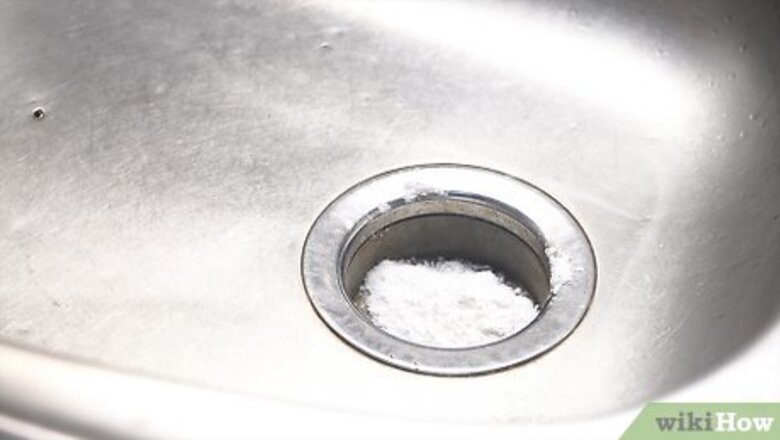
views
- Pour a large pot of scalding hot water down the drain to loosen the gunk, then pour about ½ cup (136 g) of baking soda down the drain.
- Then, add about ½ cup (118 mL) of white vinegar to the drain and cover it with a damp cloth or a stopper. Let the mixture sit and fizz for about an hour.
- Remove the cloth or stopper and flush the drain with more hot water to clear it out.
Clearing Clogs with Baking Soda & Vinegar
Fill a large pot with very hot water and pour it down the drain. Heat a pot or tea kettle full of water on your stovetop until it’s scalding (not quite boiling). Then, remove the drain cover (if there is one) and pour the hot water down the drain to dissolve and wash away grease, grime, and loose debris particles. If the clog is very minor, the water alone might be enough to clear the drain. Do not pour boiling water down the drain since it may damage the seals between PVC pipes. If you can see any solid objects that are obstructing the drain (like a hair clump or a chunk of food), use a wire coat hanger to remove them before pouring the hot water. If your sink or tub isn’t draining at all, add enough water to cover the bottom of a plunger and give the drain a few pumps until you notice the water start to trickle down.
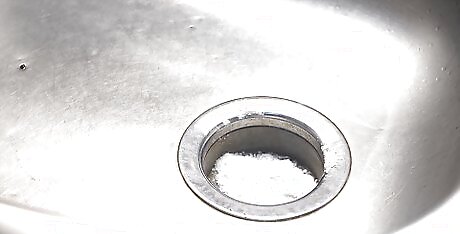
Pour about ½ cup (136 g) of baking soda down the drain. Measure out ½ cup (136 g) of baking soda (it doesn’t have to be exact—anywhere from ⅓ of a cup (91 g) to a half a box should do the trick). Then, carefully empty the baking soda into your clogged drain. If your sink has a stopper, use a cotton swab to push all of the baking soda into the drain. To keep the baking soda from sticking as you pour it, dry off the inside of your sink or tub with a rag beforehand. For extra tough clogs, add ½ cup (136 g) of salt in addition to the baking soda. Tip: A baking soda and vinegar mixture will also safely clean your garbage disposal. Follow the same instructions (just make extra sure that the disposal is unplugged or turned off while you clean it).
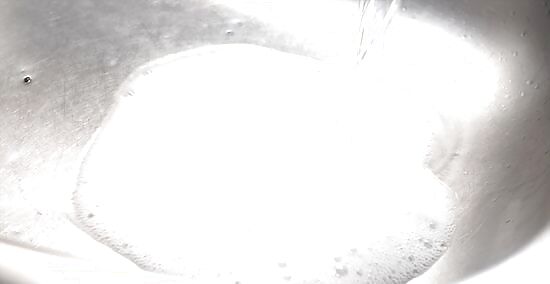
Pour about ½ cup (118 mL) of white vinegar down the drain next. Again, the measurement doesn’t have to be exact as long as you use about the same amount of vinegar as baking soda. Pour the vinegar into the drain slowly over the baking soda. This will cause an instant, fizzy reaction between the two ingredients that will begin to unclog your drain. This reaction may not have a large effect if your drain is clogged by lots of hair. If baking soda and vinegar doesn’t work, try using a drain snake instead.
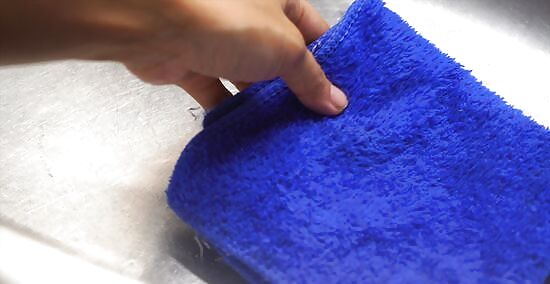
Cover the drain with a damp cloth for 1 hour. Place a damp or wet cloth over the opening of the drain to seal in the baking soda and vinegar (this makes them more potent). Let the ingredients sit in the drain for at least a full hour (or longer for a severe clog). If you leave them for a briefer period of time, they are unlikely to unclog your drain. Alternatively, just close the drain’s stopper (if it has one).

Flush the drain with another full pot of hot water. Toward the end of 1 hour, begin heating more water on your stove top. Once an hour is up, remove your cloth or stopper from the drain and slowly pour the scalding water down the drain to wash away the baking soda, vinegar, and the remaining traces of the clog. Pour the water slowly so it doesn’t splash back and burn you. Alternatively, turn on the faucet to the hottest temperature and let the water run for several minutes to flush the drain.

Repeat the process if necessary until the drain empties freely. If baking soda and vinegar do not successfully unclog your drain the first time you use them, try again. These natural ingredients won't harm your sinks or drains. It may take 2 or 3 tries for the reaction to successfully remove all of the buildup clogging your drains. To prevent future drain buildups, pour equal parts baking soda and vinegar down the drain, let them sit for 10 minutes, then flush with hot water every few weeks or months.
Other Baking Soda Mixtures
Swap lemon juice for vinegar for an alternate all-natural drain cleaner. First, loosen the gunk in your drain by running hot water from the faucet for a few minutes or pouring scalding hot water from the stove down the drain. Then pour about 1 cup (272 g) of baking soda down the drain little by little so it doesn’t all sit at the top, followed by 1 cup (237 mL) of lemon juice. Cover the drain with a stopper or damp cloth and let the mixture sit and fizz for at least 30 minutes. Flush the drain with hot water from the faucet or stove. If the drain isn’t fully unclogged, repeat the baking soda and lemon juice treatment until it is. The acid in lemon juice works similarly to vinegar and covers any smells in the drain with a fresh, citrus scent.
Try a baking soda, salt, and cream of tartar mixture for tough clogs. First, clean up as much gunk in and around the drain as you can with a wire coat hanger or paper towels. Then, combine ½ cup (136 g) of baking soda, ½ cup (136 g) of salt, and ⅛ cup (20 g) of cream of tartar in a jar, put on the lid, and shake the mixture to evenly mix the ingredients. Pour half the mixture down the drain (saving the other half for your next clog), then add 2 cups (473 mL) of scalding hot water. Let the mixture sit for about 1 hour. After an hour, run hot water from the faucet for a few minutes or pour a pot of hot water from the stove down the drain to flush it out. The salt and baking soda will break up the clog, and the cream of tartar will clean the metal in and around the drain. Out of cream of tartar? No problem! Pour equal parts baking soda and salt down the drain and let it sit for at least 30 minutes before flushing with hot water.
Doing a Routine Cleaning With Baking Soda
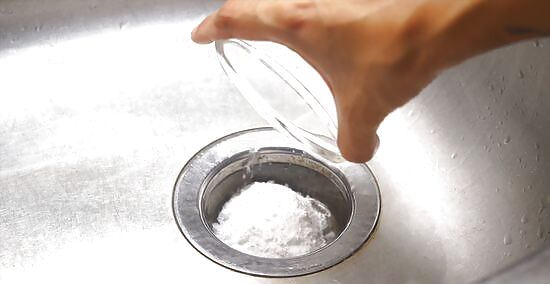
Pour about ¼ cup (68 g) of baking soda down the drain weekly. Baking soda is mildly abrasive and can help keep your drains clear with regular applications. For a routine cleaning, measure out ¼ cup (68 g) of baking soda and sprinkle it into the drain. Dry out the inside of your sinks or tub first to prevent the baking soda from sticking to them.
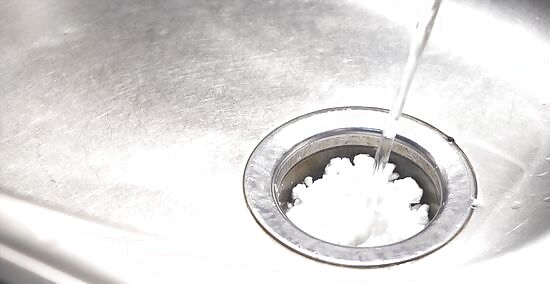
Drizzle about ⅛ cup (30 mL) of warm water over the baking soda. Moisten the baking soda so it sticks to the inside of the drain. Drip the water slowly and gently to avoid washing the baking soda down the sink. Alternatively, moisten the baking soda with a fine mist of warm water from a spray bottle.

Let the moist baking soda sit for 1-2 hours. To clean your drains effectively, baking soda will have to sit for at least 60 minutes to permeate dirt and other buildup. Set a timer for an hour to keep track of the time. Avoid using the sink or tub before then. In addition to cleaning debris, baking soda is also a natural deodorizer that will keep your drains or garbage disposals from stinking.

Run warm water from the tap to flush the baking soda away. After an hour or two, turn on the tap. Run warm to hot water down the drain for several minutes. This should be enough to flush away the baking soda and any debris it loosened from your drain. Repeat this cleaning process on your drains once a week to avoid clogs. If you used baking soda to refresh your garbage disposal, turn on the disposal while you flush the baking soda away.


















Comments
0 comment